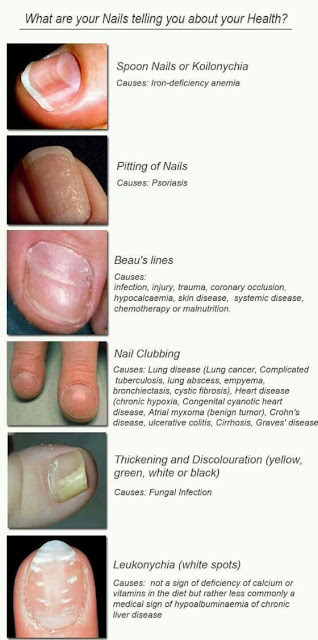Nail disease and disorder.
Did you know that your fingernails can provide clues to your overall health?
For example, ice pick-like depressions in the nails (nail pitting) are common in people who have psoriasis — a condition characterized by scaly patches on the skin. Nail pitting can also be related to connective tissue disorders, such as Reiter's syndrome, and alopecia areata — an autoimmune disease that causes hair loss.
Nail clubbing occurs when the tips of the fingers enlarge and the nails curve around the fingertips, usually over the course of years.
Nail clubbing is sometimes the result of low oxygen in the blood and could be a sign of various types of lung disease. Nail clubbing is also associated with inflammatory bowel disease, cardiovascular disease, liver disease and AIDS.
Spoon nails (koilonychia) are soft nails that look scooped out. The depression usually is large enough to hold a drop of liquid.
Often, spoon nails are a sign of iron deficiency anemia or a liver condition known as hemochromatosis, in which your body absorbs too much iron from the food you eat. Spoon nails can also be associated with heart disease and hypothyroidism.
With the condition known as Terry's nails, most of the nails appear white except for a narrow pink band at the tip.
Terry's nails can sometimes be attributed to aging. In other cases, Terry's nails can be a sign of a serious underlying condition, such as liver disease, congestive heart failure, kidney failure or diabetes.
With a condition known as onycholysis, the fingernails become loose and can separate from the nail bed. The separated part of the nail becomes opaque with a white, yellow or green tinge.
Sometimes detached nails are associated with injury or infection. In other cases nail separation is a reaction to a particular drug or consumer product, such as nail hardeners or adhesives. Thyroid disease and psoriasis — a condition characterized by scaly patches on the skin — also can cause nail separation.
With yellow nail syndrome, nails thicken and new growth slows. This results in a yellowish discoloration of the nails.
Nails affected by yellow nail syndrome might lack a cuticle and detach from the nail bed in places. Yellow nail syndrome is often a sign of respiratory disease, such as chronic bronchitis. Yellow nail syndrome can also be related to swelling of the hands (lymphedema).
Did you know that your fingernails can provide clues to your overall health?
For example, ice pick-like depressions in the nails (nail pitting) are common in people who have psoriasis — a condition characterized by scaly patches on the skin. Nail pitting can also be related to connective tissue disorders, such as Reiter's syndrome, and alopecia areata — an autoimmune disease that causes hair loss.
Nail clubbing occurs when the tips of the fingers enlarge and the nails curve around the fingertips, usually over the course of years.
Nail clubbing is sometimes the result of low oxygen in the blood and could be a sign of various types of lung disease. Nail clubbing is also associated with inflammatory bowel disease, cardiovascular disease, liver disease and AIDS.
Spoon nails (koilonychia) are soft nails that look scooped out. The depression usually is large enough to hold a drop of liquid.
Often, spoon nails are a sign of iron deficiency anemia or a liver condition known as hemochromatosis, in which your body absorbs too much iron from the food you eat. Spoon nails can also be associated with heart disease and hypothyroidism.
With the condition known as Terry's nails, most of the nails appear white except for a narrow pink band at the tip.
Terry's nails can sometimes be attributed to aging. In other cases, Terry's nails can be a sign of a serious underlying condition, such as liver disease, congestive heart failure, kidney failure or diabetes.
With a condition known as onycholysis, the fingernails become loose and can separate from the nail bed. The separated part of the nail becomes opaque with a white, yellow or green tinge.
Sometimes detached nails are associated with injury or infection. In other cases nail separation is a reaction to a particular drug or consumer product, such as nail hardeners or adhesives. Thyroid disease and psoriasis — a condition characterized by scaly patches on the skin — also can cause nail separation.
With yellow nail syndrome, nails thicken and new growth slows. This results in a yellowish discoloration of the nails.
Nails affected by yellow nail syndrome might lack a cuticle and detach from the nail bed in places. Yellow nail syndrome is often a sign of respiratory disease, such as chronic bronchitis. Yellow nail syndrome can also be related to swelling of the hands (lymphedema).




